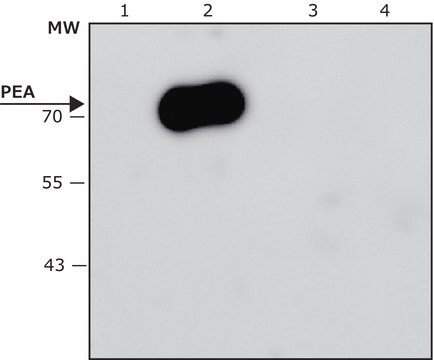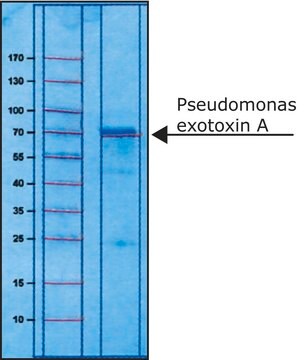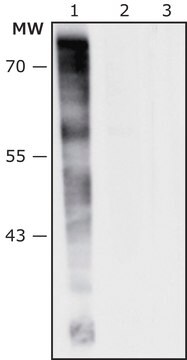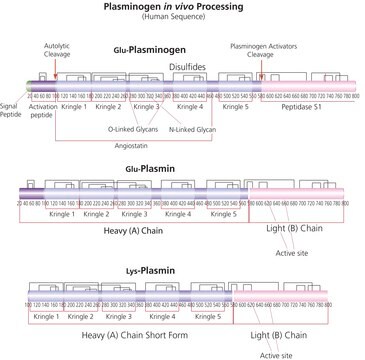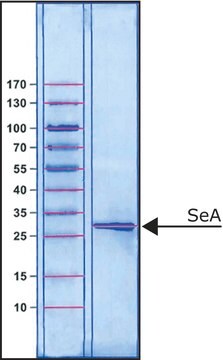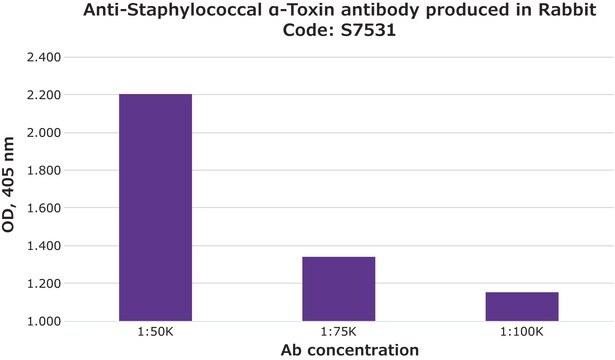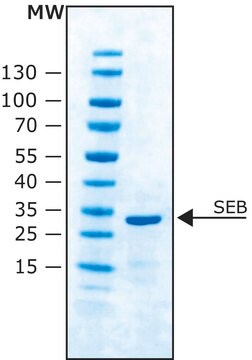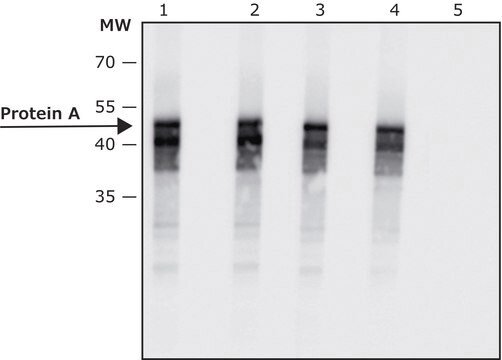P2318
Anti-Pseudomonas Exotoxin A antibody produced in rabbit
whole antiserum
Synonym(s):
Anti-ETA
Sign Into View Organizational & Contract Pricing
All Photos(1)
About This Item
Recommended Products
biological source
rabbit
conjugate
unconjugated
antibody form
whole antiserum
antibody product type
primary antibodies
clone
polyclonal
contains
15 mM sodium azide
species reactivity
(Pseudomonas aeruginosa)
technique(s)
dot blot: 1:20,000
indirect ELISA: 1:250,000
shipped in
dry ice
storage temp.
−20°C
target post-translational modification
unmodified
Gene Information
Pseudomonas aeruginosa PAO1 ... toxA(877850)
General description
Reacts against Pseudomonas exotoxin A, but shows no reaction against Staphylococcal enterotoxin A, Cholera toxin, and Staphylococcal enterotoxin B. The product has not been tested for neutralization potency against active Pseudomonas exotoxin A.
Immunogen
exotoxin A from Pseudomonas aeruginosa.
Application
Anti-Pseudomonas Exotoxin A antibody has been used in in vitro serum stability of fusion toxins and binding of targeted toxins.
Anti-Pseudomonas exotoxin A antibody produced in rabbit has been used:
- in the in vitro analysis of the stability of fusion toxins in serum
- to construct an epidermal growth factor receptor (EGFR)-targeted toxin to study its toxicity on Swiss mouse embryo NIH-3T3 cells transfected with human EGFR
- in the determination of the in vivo half-life of immunotoxins in serum
Biochem/physiol Actions
Pseudomonas exotoxin A is secreted by Pseudomonas aeruginosa and has potent cytotoxic effects. Exotoxin A enters the cells by receptor-mediated endocytosis, translocates to the cytoplasm and inhibits protein synthesis by ADP-ribosylating factor 2. Chimeric exotoxin A has applications in gene treatment of various diseases and probable treatment for cancer.
Physical form
This product is supplied as a liquid containing 15 mM sodium azide as preservative.
Storage and Stability
For continuous use, store at 2-8 °C for up to one month. For extended storage, the solution may be frozen in working aliquots. Repeated freezing and thawing is not recommended. Storage in "frost-free" freezers is not recommended. If slight turbidity occurs upon prolonged storage, clarify the solution by centrifugation before use.
Disclaimer
Unless otherwise stated in our catalog or other company documentation accompanying the product(s), our products are intended for research use only and are not to be used for any other purpose, which includes but is not limited to, unauthorized commercial uses, in vitro diagnostic uses, ex vivo or in vivo therapeutic uses or any type of consumption or application to humans or animals.
Not finding the right product?
Try our Product Selector Tool.
Storage Class Code
10 - Combustible liquids
WGK
nwg
Flash Point(F)
Not applicable
Flash Point(C)
Not applicable
Choose from one of the most recent versions:
Already Own This Product?
Find documentation for the products that you have recently purchased in the Document Library.
Asghar Tanomand et al.
Iranian biomedical journal, 17(1), 1-7 (2013-01-03)
Infections due to Pseudomonas aeruginosa are among the leading causes of morbidity and mortality in patients who suffer from impaired immune responses and chronic diseases such as cystic fibrosis. At present, aggressive antibiotic therapy is the only choice for management
Chao Pan et al.
mBio, 7(2), e00443-e00416 (2016-04-28)
Conjugate vaccines are known to be one of the most effective and safest types of vaccines against bacterial pathogens. Previously, vaccine biosynthesis has been performed by using N-linked glycosylation systems. However, the structural specificity of these systems for sugar substrates
Yao Wang et al.
Scientific reports, 8(1), 13344-13344 (2018-09-08)
Pseudomonas aeruginosa is a prevalent opportunistic pathogen that causes fatal infections in immunocompromised individuals. Quorum sensing (QS) is a cell-to-cell communication process that controls virulence gene expression and biofilm formation in P. aeruginosa. Here, the QS systems and the relevant
I Pastan et al.
The Journal of biological chemistry, 264(26), 15157-15160 (1989-09-15)
Pseudomonas exotoxin binds to and enters cells by receptor-mediated endocytosis. Within the cell it requires exposure to low pH to enable it to translocate to the cell cytoplasm where it inhibits protein synthesis by ADP-ribosylating elongation factor 2. The toxin
Daejin Lim et al.
Oncotarget, 8(23), 37550-37560 (2017-05-06)
The anticancer strategy underlying the use of immunotoxins is as follows: the cancer-binding domain delivers the toxin to a cancer cell, after which the toxin enters and kills the cell. TGFα-PE38 is an immunotoxin comprising transforming growth factor alpha (TGFα)
Our team of scientists has experience in all areas of research including Life Science, Material Science, Chemical Synthesis, Chromatography, Analytical and many others.
Contact Technical Service